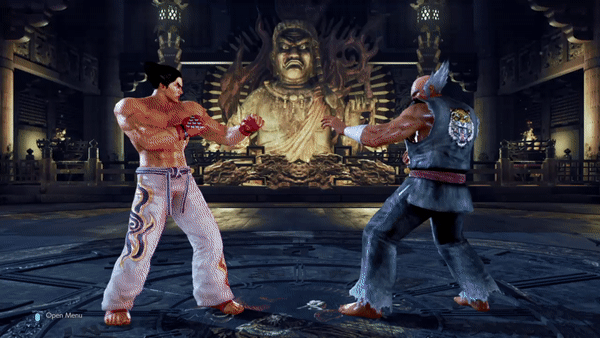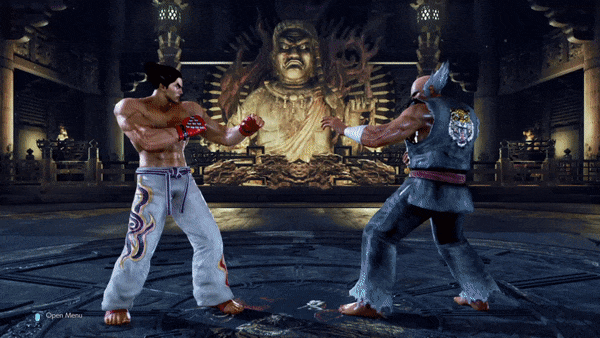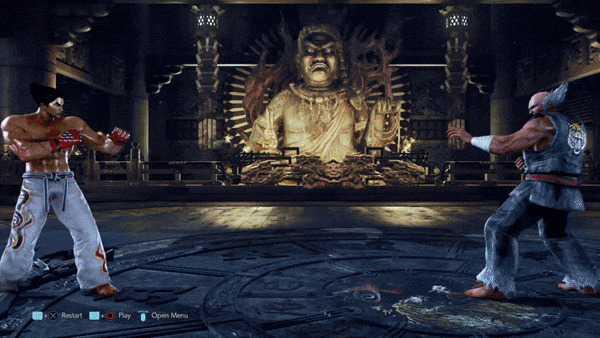
GLOSSARY
If you are new to Tekken or fighting games in general, it is understandable that you would find yourself getting confused by terms such as "whiff punish" or "low crush" while reading articles on our website or content from the wider Tekken or general fighting game community (FGC). Our glossary of common Tekken and general fighting game terms is intended to enlighten and will hopefully help you on your way to becoming a learned member of the FGC.
Aside from this, it would also be useful to familiarise yourself with basic Tekken notations.
-
"Capo"
A character that practices the art of capoeira, i.e. Christie Monteiro and her instructor and friend Eddy Gordo.
-
To "chicken"
To escape an attack reversal by one of the characters Anna Williams, Asuka Kazama, Sergei Dragunov, Lili De Rochefort, Nina Williams or Paul Phoenix. The term is derived from a glitch in earlier Tekken games where the announcer would yell "Chicken!" after a player managed to escape an attack reversal. This has since been maintained as an intentional reaction from the announcer upon escaping an attack reversal.
-
"Clutch"
Used to describe something happening at a crucial moment in play, where the outcome of the round, match or set is at stake.
-
"Combo"
A set of attacks landed in sequence while the opponent is in a vulnerable state (e.g. airborne). Performing a combo on an airborne opponent is also known as "juggling."
-
"(High/low) crush"
An attack that avoids high or low attacks from the opponent at certain points of its animation. A high-crushing attack typically involves the character getting their body into a low position, allowing them to avoid high attacks in the process, while a low-crushing attack typically involves the character jumping, thereby evading low attacks in the process.
-
To "duck"
To avoid a high attack by crouching.
-
"FGC"
Fighting game community.
-
To "float"
To use an attack to interrupt the opponent during a move that leaves them airborne, leading to a combo. A character may also be "floated" off the ground after blocking some low attacks, especially those that involve the character sliding.
-
"Frames" (in)
A measure of time in animation. In Tekken, one frame represents 1/60th of a second (see our guide to frame data for more). The abbreviation for frames is i (e.g. i10 = 10 frames).
-
"FTn"
A contest in which a player must win n matches against the opponent to win (e.g. FT2 = First to 2; first player to win 2 matches wins the set).
-
"Getup kick"
A kick performed from a grounded position (see also: "Toe kick").
-
"High"
An attack that hits a standing opponent but whiffs against a crouching opponent.
-
"HP"
Health points; refers to a player's health bar at the top of the screen during play.
-
"Jab"
A short straight punch; coming out in 10 frames, the quickest attack for most Tekken characters (see our guide to frame data for more).
-
To "jail"
To lock the opponent in a blocking state with a string that renders them unable to move.
-
"Just frame"
A particular frame or window of frames in the animation of a move during which an input must be executed. Just frame inputs are denoted by a colon (:) in Tekken notation. Examples include Paul's Phoenix Bone Breaker (f, f+2:1) and Demolition Man (d+4:2:1+2).

Comparison between Paul's Juggernaut (f, f+2, 1) and the just frame Phoenix Bone Breaker (f, f+2:1)
-
To "launch"
To send your opponent flying into the air or otherwise put them in a state that leaves them vulnerable for a combo (e.g. a crumple stun); a move that does this is known as a "launcher" or a "juggle starter."
-
"Low"
An attack that hits both standing and crouching opponents and must be blocked while crouching or avoided by jumping.
-
"(To) main"
Refers to a character that a player specialises with (e.g. "Kazuya main Otieno played well" or "Otieno, a Kazuya main, played well"). In an instance where a player specialises with more than one character, they may describe themselves as having multiple "mains" (where they have no particular preference for either of the characters) or "secondary mains" (where they feel their knowledge on or ability with one character is superior to those with the others).
As such, "to main" means to specialise with one or more characters (e.g. "Wambui mains Nina").
-
"Match"
A contest in which a player must win a given number of rounds against the opponent to win.
-
"Mid"
An attack that hits both standing and crouching opponents, but can only be blocked while standing; a special mid can be blocked either while standing or crouching.
-
"Minus frames"
Used to indicate when a player has frame disadvantage (see our guide to frame data for more). A move that gives the player frame disadvantage after it hits or is blocked is described as "minus on hit/block."
-
"Mirror (match)"
A match in which both players use the same character.
-
"Mishima(s)"
A character that practices the fictional art of Mishima-ryū karate:
- Heihachi Mishima (based on Gōjū-ryū karate)
- Kazuya Mishima, son of Heihachi and father of Jin Kazama (based on Shotokan karate)
- Devil Jin, Jin's demonic alter-ego (based on Shitō-ryū karate and Ko-ryū bujutsu)
In the story of Tekken 3, Jin Kazama practices Mishima-ryū karate until his betrayal by Heihachi, after which he switches to "traditional karate" (based on Kyokushin karate) from Tekken 4 onwards; the Tekken Project team gave Devil Jin his normal self's Tekken 3 moves when he was introduced in Tekken 5, as well as additional "demonic" abilities.
The "Mishima" term also often extends to Jin and his paternal grandmother Kazumi Mishima (née Hachijō), due to similarities in their respective fighting styles to Mishima-ryū karate. Kazumi practices a mix of the fictional Hachijō-ryū karate (influences unclear) and Mishima-ryū karate.
As a playstyle, the "Mishima" term refers mainly to:
- Using the wavedash to put the opponent in a mix-up between the low Spinning Demon, commonly known as the hellsweep (f, n, d, d/f+4) and a mid launcher (such as f, f+3 for Kazuya and Heihachi or f, n, d, d/f+3 for Devil Jin)
- Using movement and spacing to set up whiff punishment with the Electric Wind God Fist (EWGF; f, n, d, d/f+2)

Hellsweep from wavedash mix-up

Mid launcher from wavedash mix-up

Whiff punish with EWGF
-
"Mix-up"
A situation in which a player forces the opponent to guess whether they are going to attack mid or low (a "true mix-up").
While there are also situations that force a player to guess between high and mid or high and low, these are not known as "true mix-ups". A mix-up between high and mid can be dealt with by blocking while standing to negate both options, while a mix-up between high and low can be dealt with by ducking, which will avoid high attacks and block or low parry (performed by crouching forward; see our guide to attacking and defending for more) low attacks.
-
"Okizeme" (起き攻め)
Often shortened to "oki" and also known as "wake-up", "wake-up game" or "ground game"; refers to pressuring the opponent while they are on the ground, forcing them to think about how to get up safely. In some cases, "okizeme" and "wake-up" may be used to distinguish between the aggressor and the opponent in this situation; the former referring to the aggressor pressuring the opponent while they are on the ground and the latter referring to the opponent getting up safely.
The word "okizeme" is a portmanteau of the Japanese words "okiru" (起きる; "to wake up") and "semeru" (攻める; "to attack" or "to strike").
-
"Parry"
A move that deflects the opponent's attack and, in most cases, gives the player plus frames. A low parry can be performed by any character and puts the opponent in a bound state (introduced in Tekken 6), leaving them open for a combo.
-
"Playstyle"
The general strategy or game plan used by a player during play (e.g. "Kamau has an offensive playstyle"), or the general strategy or game plan best suited for a particular character (e.g. "Asuka's playstyle involves a lot of turtling").
-
"Plus frames"
Used to indicate when a player has frame advantage (see our guide to frame data for more). A move that gives the player frame advantage after it hits or is blocked is described as "plus on hit/block."
-
To "poke"
To steadily inflict minor damage on the opponent with short, quick and (usually) mid or low attacks at close range to disrupt their pressure or force them into advancing impatiently, setting up more damaging attacks and/or combos as a result.
-
To "punish"
To attack your opponent after blocking their move (a "punish" or more specifically a "block punish") or avoiding their move (a "whiff punish"), during the recovery of that move.
-
"Rage"
Introduced in Tekken 6, a state in which—once left with low health—a character is given a boost in damage and, since Tekken 7, access to special attacks known as rage arts and rage drives (see our guide to attacking and defending for more on these).
-
"Range"
The reach of a given attack. Attacks with long range are said to "have good range" or simply "have range", while attacks with short range are said to "have bad range" or "lack range."
-
"Recovery"
The final stage in the animation of a move, during which the character returns to their neutral state after performing the move.
-
"(Attack) reversal"
A move that involves a character parrying the opponent's attack or grabbing the opponent's limb during an attack and returning an attack of their own.
-
"Round"
A segment of a match in which a player must completely deplete the opponent's health bar or (in timed rounds) finish with more health than the opponent at the end of the specified time. A round may be timed up to 99 seconds or have infinite time.
-
To "rush down"
To play in an aggressive or offensive manner; usually involves a lot of poking, sidestepping, mix-ups and dictating play with moves that are plus on block (see our guide to frame data for more). An aggressive or offensive style of play is therefore known as "rushdown."
-
"Sabaki"
An attack that automatically reverses attacks from the opponent during certain points of its animation.
-
"Safe (on block/hit)"
Used to describe an attack that cannot be punished after it hits or is blocked. Safe attacks may leave the character in plus frames, neutral frames or minus frames (see our guide to frame data for more).
-
"Set"
A contest in which a player must win a given number of matches against the opponent to win. Sets are usually specified as FTn (first to win n matches).
-
"Start-up"
The first stage in the animation of a move, during which the character leaves their neutral state and begins to perform the move (if the move is an attack, the stage of the animation prior to the attack landing is its start-up).
-
"String"
A series of multiple hits in an attack. Some strings may be blocked, evaded or interrupted at certain hits, while others jail. Strings that are guaranteed to connect with the opponent on each hit are known as "natural combos."
-
"Tier list"
A ranking system for characters based on the advantages/disadvantages and practicality of their respective moves in a number of situations. Tier lists are almost always unofficial and generally arrived at based on one's own opinion. As such, characters may be described as "low-tier", "mid-tier", "S-tier" (where characters are given letter grades with S being the highest, typically followed by A, B and C) and so on.
TEKKEN 254 has its own Tekken 7 tier list, which can be found in our character guide.
-
"Toe kick" (Recovery kick)
A type of getup kick done specifically from the knockdown position (on the ground with the face up and feet towards the opponent; see our guide to notations for more). The character uses their right foot to kick the opponent's toe before rolling backwards and standing up (on hit) or standing straight up (on block).
-
To "turtle"
To play in a defensive manner; often characterised by good spacing and inflicting damage primarily through block punishment and whiff punishment.
-
"Unsafe (on block/hit)"
Used to describe an attack that can be punished after it hits or is blocked. Unsafe attacks will always leave the character in minus frames (see our guide to frame data for more).
-
To "wavedash"
To perform multiple crouch dashes (f, n, d, d/f) in quick succession to close distance quickly and pressure the opponent (see our guide to movement for more).
-
To "whiff"
To fail to make contact with the opponent with an attack, i.e. to miss the opponent.





